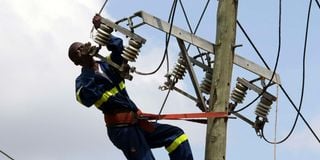Premium
Inside Kenya Power model for sharing electricity distribution

A Kenya Power technician fixes high voltage electricity line along Kenyatta Avenue in Nairobi on November 3, 2015.
It is a little more than a week since electricity distribution monopoly Kenya Power moved for the first time to share the huge responsibility of providing the country with round-the-clock power supply with any private distributor willing to take on the task.
The utility has given investors up to October 18 to express their interest in helping the company to distribute power in some nine slums within Nairobi which are not fully connected to the national grid.
On Friday, Kenya Power Managing Director Joseph Siror, who was appointed to the helm of the company in May, revealed to Nation in an interview the rationale behind the move.
“What we have noticed is that there are places which are not adequately served and others which have connections that are not safe. We then asked ourselves, how best can we serve these people? This is the genesis of this idea,” said Dr Siror.
The utility has earmarked Mukuru, Mathare, Kibera, Kibagare, Deep Sea, Mji wa Huruma, Githogoro, Kiambiu and Kamukunji as the areas in which private developers are expected to battle it out to provide power distribution services.
The investors are expected to build and maintain medium and low voltage installations, meter customers and collect revenues from the customers.
Kenya Power is already currently selling electricity in bulk to Two Rivers Power Company, a subsidiary of Two Rivers Development Ltd, which resells the power at a margin to residents of the real estate development.
Tatu City Power Company and Erdemann Property Limited, which owns the Greatwall Gardens real estate in Athi River, also have power distribution licenses from the Energy and Petroleum Regulatory Authority (Epra) to distribute electricity within their establishments.
This is, however, the first time private power distribution will be done on a large scale covering hundreds of thousands of customers, even as Kenya Power eyes to scale up the project to other parts of the country depending on the success of the Nairobi phase.
“At times the best way to approach an issue is not to listen to yourself. It is to go out there and get to know what ideas other people have. From the responses (from prospective investors) we will weigh the models they are proposing,” said Dr Siror.
He added that the company is open to on-boarding multiple distributors to serve the different selected areas, adding that investors can propose a model of their choice, that is buying power in bulk from the utility and reselling at a margin or selling for a commission.
Another model that the Kenya Power boss has proposed is where the utility undertakes all the infrastructure development including metering and thereafter bring in a third party such as an individual, company or community-based organisation to manage a specific area.
“Once we have started with the areas that we have listed it will give us results that will assist us to improve on it so that we know that this is the best model. Depending on the area, the models might differ based on different parameters,” said Dr Siror.
In Mukuru slums, the areas being targeted to be served by private players include Mukuru kwa Njenga, Mukuru kwa Reuben, Sinai, Lunga Lunga, Shimo la Tewa, Masai, Fuata Nyayo, Moto Moto, Wape Wape, Vietnam, Riara, Crescent, Sisal, Zone 48, Kingstone and Jamaica.
In Kibera, the areas include Gatwekera, Soweto, Lindi, Laini Saba, Makina, Silanga, Raila, Kianda, Kisumu Ndogo, Kambi Muru and Mashimoni while in kamukungi it includes Kamukunji Jua Kali, Muthurwa Market and Biafra.
In Mathare, some of the areas that will be served by the private distributors are Ngomongo, Mathare 4B, Korogocho, Gitathuru, Kosovo and Gitari Marigu.
“We really want to move as fast as possible to actualise this. A lot will depend on the responses we get. Once we get to see the proposals that we receive then it will guide how fast we move forward,” said Dr Siror.
The utility expects to benefit from both increasing the number of its customers as well as reducing its commercial losses arising from power theft. Many households in the aforementioned areas are not metered despite enjoying power supply, contributing to system losses.
“The intended model will primarily operate within regulated tariffs, prescribed network standards and within the provisions of the Energy Act, 2019. The model will see introduction of electricity retail entities/agencies within the identified settlement areas. The expected benefits, among others, improved service delivery and public safety within the selected areas,” said the firm in the expression of interest (EoI).
Earlier this year, Epra approved power tariffs that took effect on April 1 including bulk tariffs that were introduced to effect Section 163 of the Energy Act, 2019.
“We have also approved the bulk tariffs in furtherance of the provisions of Section 163 of the Energy Act, 2019. This will allow large consumers to buy power at bulk from Kenya Power and to retail the same to their end user customers,” said Epra.
In the new tariffs, large customers of category CI5 will buy power at a bulk base tariff of Sh11.98 in the current financial year ending June 2024, Sh11.40 in 2024/25 and Sh11.16 in FY2025/26.
In comparison, unsubsidised domestic consumers will buy the same electricity from Kenya Power at a base tariff of Sh20.58 in the fiscal year 2023/24, Sh19.08 and Sh18.57 per unit over the next two years respectively.
The move will also see the utility partially offset its commercial losses – Kenya Power’s total system losses stood at 22.43 percent in the year to June 2022 – nearly half of which were commercial.
During that period, the utility was allowed by Epra to pass on 19.9 percent of these losses to consumers, while the remainder is shouldered by the company.
Kenya Power estimates that for every one percent loss, it incurs about Sh800 million which translates to a total loss of Sh2 billion, which the company incurred from the system losses in that year.





